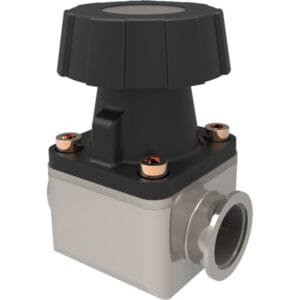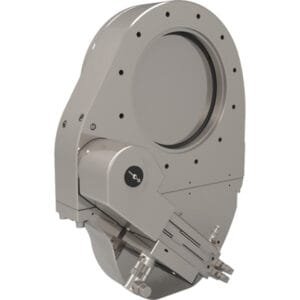KF (QF) HV Stainless Steel Weld Flanges (Inch Tube): Robust Weldable Interfaces for Inch-Based High-Vacuum Applications
KF (QF) HV Stainless Steel Weld Flanges (Inch Tube) are critical components for constructing high-vacuum systems that rely on inch-sized tubing and standardized KF connections. These weld flanges are designed to deliver leak-tight, mechanically stable transitions between welded stainless steel tubing and modular KF (QF) flange systems. Whether applied in foreline plumbing, vacuum chamber ports, or instrumentation access points, these flanges provide a clean and permanent solution for system integration.
TFM manufactures KF (QF) HV Stainless Steel Weld Flanges (Inch Tube) from either 304L or 316L stainless steel, depending on application requirements. The 304L grade offers excellent corrosion resistance and strength for general-purpose vacuum environments, while the 316L version provides enhanced performance in chemically aggressive or high-humidity conditions. Both variants are fully compatible with high-vacuum use, delivering outstanding durability and weldability across a range of operational demands.
The KF (QF) flange incorporated into each KF (QF) HV Stainless Steel Weld Flange (Inch Tube) follows the well-established sexless design, allowing easy alignment and quick connection using centering rings and circumferential clamps. This KF connection method is widely favored in high-vacuum systems for its simplicity and effectiveness. The flange is chamfered on its back surface to support proper sealing force distribution, and it interfaces seamlessly with other KF components to form a reliable seal down to 10⁻⁸ torr.
The sealing mechanism of KF (QF) HV Stainless Steel Weld Flanges (Inch Tube) is based on a rubber or elastomeric o-ring, housed within a centering ring that also serves as a flange guide. When clamped, the o-ring compresses between two chamfered faces to create a vacuum-tight seal. This configuration supports working temperatures from 0 °C to approximately 120–180 °C, depending on the o-ring compound. The modular quick-clamp system—tightened with a wing-nut, thumbscrew, or bolt—ensures fast, tool-free installation and removal.
Each KF (QF) HV Stainless Steel Weld Flange (Inch Tube) is precisely machined and vacuum-cleaned to support UHV-level cleanliness and structural performance. The weld-end tube portion is prepared for TIG or orbital welding, allowing technicians to easily incorporate these flanges into chamber bodies, rigid vacuum lines, pump manifolds, or diagnostic ports in inch-dimensioned systems.
TFM supplies these flanges in a full range of KF sizes, including KF16, KF25, KF40, and KF50, matched to standard inch tube diameters. We also provide custom fabrication options for specialized length, wall thickness, or electropolished internal finishes, ensuring you can meet even the most demanding engineering specifications.
In summary, KF (QF) HV Stainless Steel Weld Flanges (Inch Tube) offer a strong, permanent connection point between inch-based tubing and modular KF vacuum systems. Their stainless steel construction, high-vacuum sealing capability, and weld-ready design make them indispensable for vacuum professionals building or modifying systems that require durability, leak-tight performance, and dimensional accuracy.
Ordering Table
Accessories Table
| Description | For | Per Package | Part Number |
| Cast Clamps (SS) | KF10, KF16 Flanges | 1 | QF16-075-CS |
| Cast Clamps (SS) | KF25 Flanges | 1 | QF25-100-CS |
| Cast Clamps (SS) | KF40 Flanges | 1 | QF40-150-CS |
| Cast Clamps (SS) | KF50 Flanges | 1 | QF50-200-CS |
| Cast Clamps (Aluminum) | KF10, KF16 Flanges | 1 | QF16-075-C |
| Cast Clamps (Aluminum) | KF25 Flanges | 1 | QF25-100-C |
| Cast Clamps (Aluminum) | KF40 Flanges | 1 | QF40-150-C |
| Cast Clamps (Aluminum) | KF50 Flanges | 1 | QF50-200-C |
| Lever Clamps (Aluminum) | KF10, KF16 Flanges | 1 | QF16-075-CHA |
| Lever Clamps (Aluminum) | KF25 Flanges | 1 | QF25-100-CHA |
| Lever Clamps (Aluminum) | KF40 Flanges | 1 | QF40-150-CHA |
| Centering Ring (SS with Fluorocarbon O-Ring) | KF10 Flanges | 1 | QF10-050-SRV |
| Centering Ring (SS with Fluorocarbon O-Ring) | KF16 Flanges | 1 | QF16-075-SRV |
| Centering Ring (SS with Fluorocarbon O-Ring) | KF25 Flanges | 1 | QF25-100-SRV |
| Centering Ring (SS with Fluorocarbon O-Ring) | KF40 Flanges | 1 | QF40-150-SRV |
| Centering Ring (SS with Fluorocarbon O-Ring) | KF50 Flanges | 1 | QF50-200-SRV |
| Description | For | Per Package | Part Number |





Reviews
There are no reviews yet.